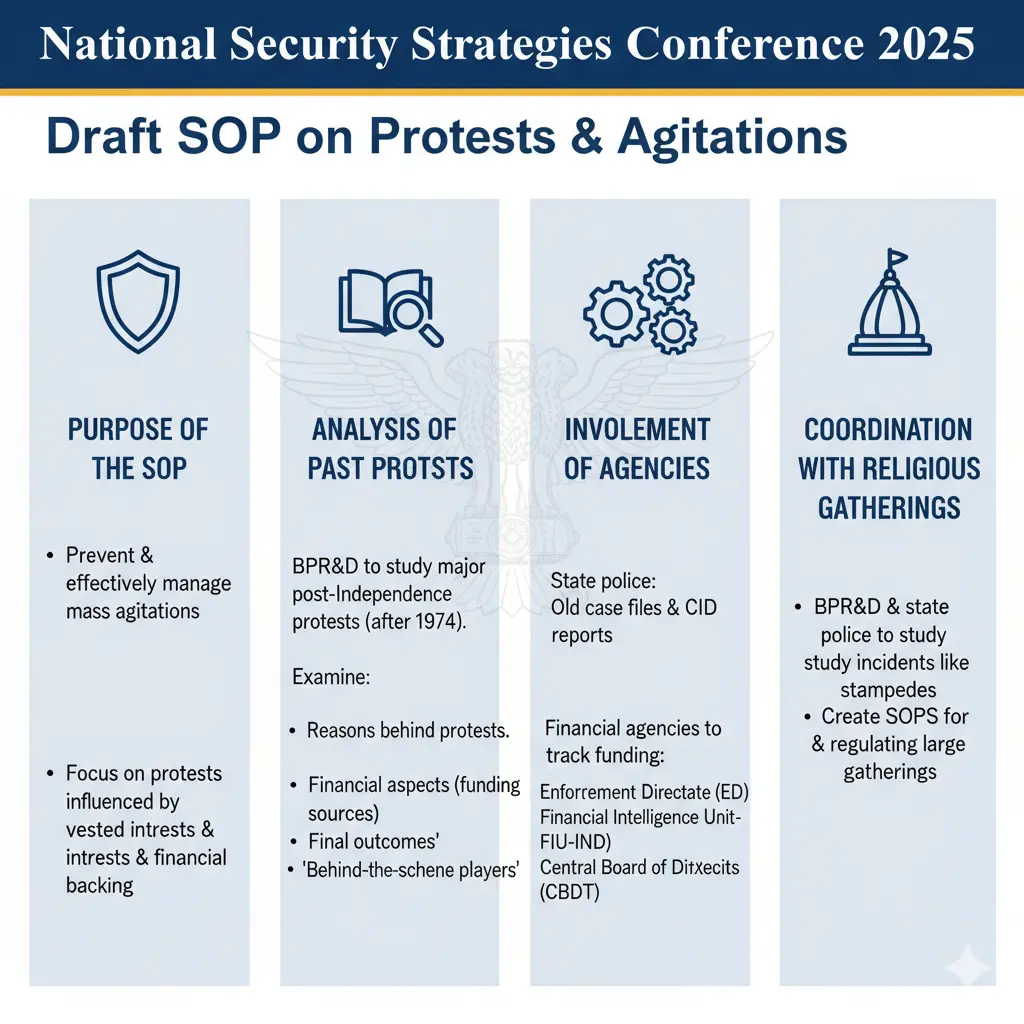September 15, 2025
National Security Strategies Conference 2025: SOP on Protests and Agitations
National Security Strategies Conference-2025
Union Home Minister Amit Shah has directed the Bureau of Police Research & Development (BPR&D) to prepare a Standard Operating Procedure (SOP) to deal with mass agitations and protests driven by vested interests by studying past protests and their funding patterns.
Key Points: National Security Strategies Conference
 Purpose of the SOP:
Purpose of the SOP:
- To prevent and effectively manage mass agitations in the future.
- Focus on protests influenced by vested interests and financial backing.
Analysis of Past Protests:
- BPR&D will study all major post-Independence protests, especially those after 1974.
- It will examine:
- Reasons behind the protests.
- Financial aspects (sources of funding).
- Final outcomes of the protests.
- “Behind-the-scene players” influencing such movements.
Involvement of Agencies:
- State police departments provide old case files and CID reports.
- Financial investigation agencies like:
- Enforcement Directorate (ED),
- Financial Intelligence Unit-India (FIU-IND),
- Central Board of Direct Taxes (CBDT),
to track protest funding sources.
Coordination with Religious Gatherings:
- BPR&D to work with state police to study incidents like stampedes at religious congregations.
- Create SOPs for monitoring and regulating large gatherings.
National Security Agencies’ Role:
NIA, BSF, and Narcotics Control Bureau (NCB) to develop strategies to:
- Identify unknown terror networks.
- Handle issues like Khalistani extremism and organized crime, especially in Punjab.
- Disrupt domestic criminal networks operating from inside jails.
Intelligence-Based Approach:
- A multi-agency task force to design a framework for preventing mass agitations.
- Includes coordination between central and state agencies for real-time intelligence sharing.
Significance:
- Aims to strengthen internal security and prevent violent mass agitations.
- Helps in tracking foreign and domestic funding of protests.
- Enhances coordination between law enforcement and intelligence agencies.
About Financial Intelligence Unit – India (FIU-IND):
Introduction:
- Established: 18 November 2004
- Headquarters: New Delhi
- Administrative Control: Under the Department of Revenue, Finance Ministry, Government of India.
- Primary Role:
- Acts as the central national agency for receiving, processing, analyzing, and disseminating information related to suspicious financial transactions.
- Plays a key role in India’s fight against money laundering, terrorism financing, and economic crimes.
Functions of FIU-IND:
Collection of Financial Intelligence:
Collects information from reporting entities such as:
- Banks,
- Financial institutions,
- Intermediaries,
- Stock exchanges,
- Insurance companies,
- Casinos, etc.
These entities are required to submit:
- Suspicious Transaction Reports (STRs)
- Cash Transaction Reports (CTRs)
- Cross Border Wire Transfer Reports (CBWTRs)
- Non-Profit Organisation Transaction Reports (NTRs)
Analysis of Reports:
Conducts data mining and analysis to identify:
- Money laundering patterns,
- Terror financing routes,
- Illicit financial flows.
Dissemination of Intelligence:
After analysis, the FIU-IND shares actionable intelligence with:
- Enforcement Directorate (ED),
- Central Bureau of Investigation (CBI),
- National Investigation Agency (NIA),
- Income Tax Department,
- Police forces,
- Other regulatory bodies like SEBI, RBI, IRDAI.
October 6, 2025
September 24, 2025
September 23, 2025
September 22, 2025
